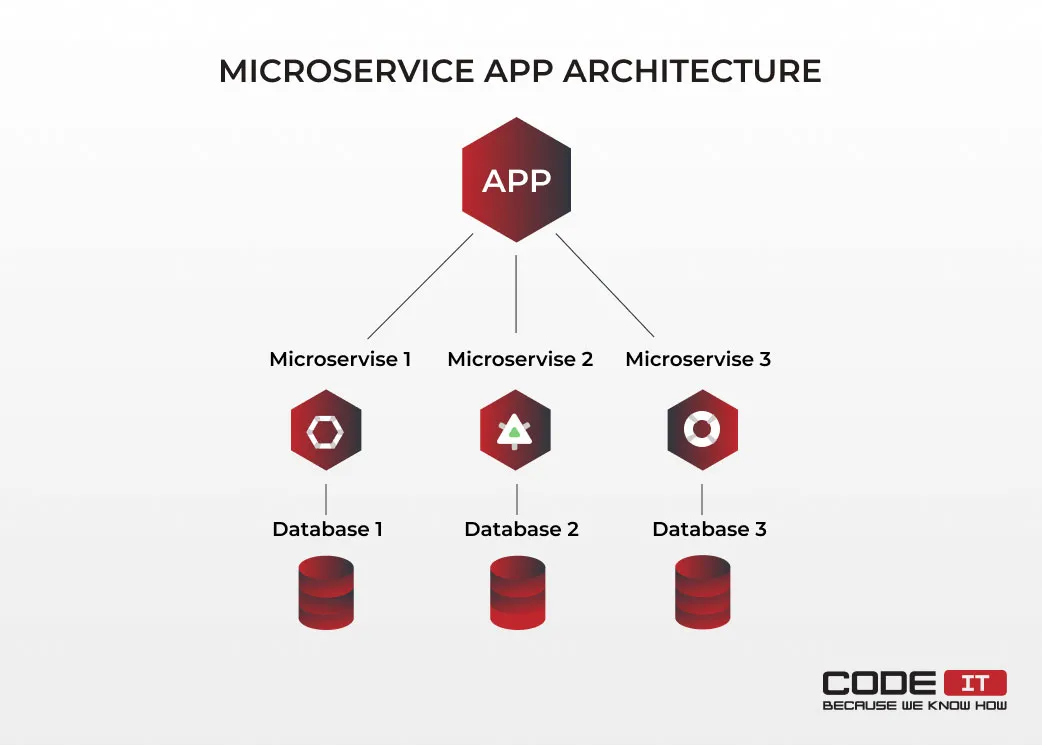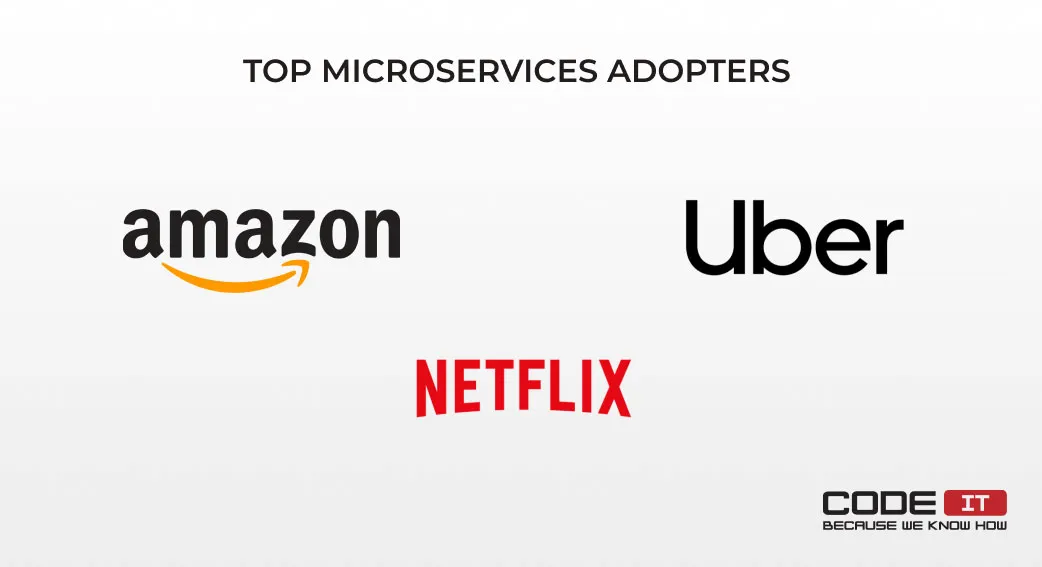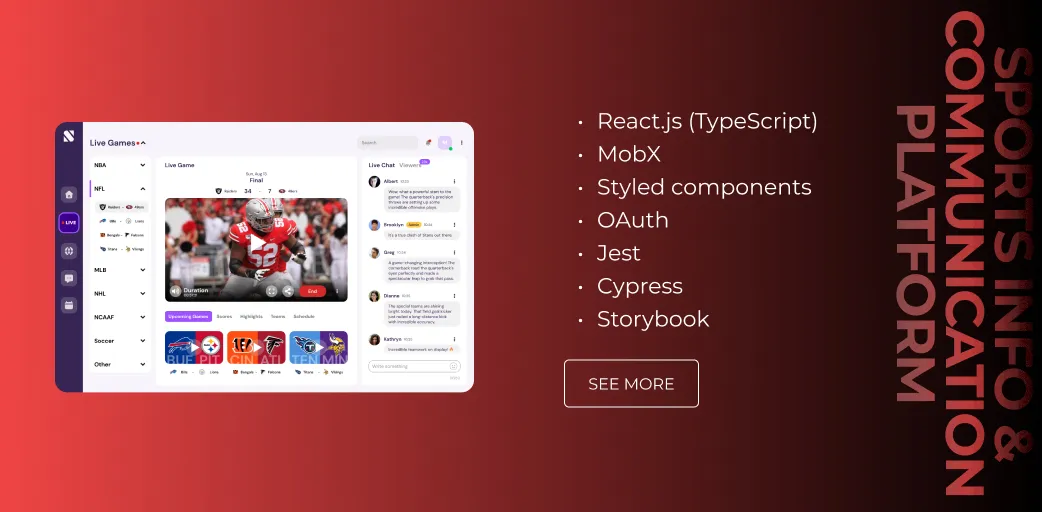Microservices Use Cases and Real-World Examples


The microservice architecture foresees the opportunity to build applications that consist of loosely-coupled components with service independence. Every microservice has a separate database and can be built using different technologies. The key characteristics of microservices-driven apps are:
- decentralized architecture
- great scalability
- failures resistance

Businesses actively adopt the microservice architecture due to its many benefits. The foremost advantages of using microservices are:
- self-sufficiency of an application
- utilization of different technologies
- apps are easy to scale and update
- improved continuous delivery
- simplified developers’ onboarding
Refactor your monolith app

Business First
Code Next
Let’s talk
Microservices Adoption Statistics
Many companies widely adopt microservices. According to the report prepared by Statista, more than 81% of companies of different sizes already use microservices.
Microsoft has conducted a comprehensive survey on the use of microservices. The presented results state that the top five microservices architecture use cases by app types are as follows.
- Data analytics — 45%
- Database applications — 41%
- Customer relationship management — 38%
- Finance — 34%
- HR applications — 31%
Roughly 92% of the microservice architecture adopters are satisfied with the chosen solution.
When Choosing Microservice Architecture
Microservices have a lot of benefits that businesses value. However, many companies start small with monolithic apps because releasing a monolith is easier and faster. Hence, microservices aren’t the best solution for all companies. Feel free to explore the most popular use scenarios when a business needs to use the microservice architecture.
The microservice architecture is the right choice if you:
- expect your startup to grow at a high pace
- are not satisfied with product development time
- want to use various technologies
- can afford to employ several teams of developers
- strive to develop a highly reliable and failure-proof application
- want to be capable of modernizing your app fast
Benefits of Microservices Architecture
Advantages of Microservices
The usage of the microservices architecture helps businesses to launch optimized software solutions. They can be easily scaled up by seamlessly adding new features and using various technologies like rest APIs, supporting DevOps practices and ensuring business agility. The foremost benefits of using the microservice architecture are as follows.
- Self-sufficiency of an application—each service works as an independent entity and has no crucial dependencies with other services in an app’s architecture. As a consequence, the failure of one or several services doesn’t make an app go down—only certain features may appear to be unavailable, improving fault tolerance.
- Utilization of different technologies—the microservice architecture enables the opportunity to connect various services that utilize different technologies. Software engineers are not constrained by a list of supported technologies. The ability to pick any tech stacks for different services helps achieve optimal performance, enhanced security, and new feature implementation.
- Apps are easy to scale and update—the flexibility of the microservice architecture allows businesses to scale certain services easily with kubernetes for container orchestration. It enables a cost-effective way of horizontal scaling, leveraging scaling advantages to optimize performance. Moreover, the architecture helps avoid an app’s downtime during an update, ensuring compliance with compliance standards, while making only certain functionality inaccessible during the updating process.
- Improved continuous delivery—developers can create, test, and release new functionality, avoiding the release of new versions of the full application. This aligns with the CI/CD/CD development cycle, ensuring continuous delivery while eliminating bottlenecks and improving deployment efficiency.
- Simplified developers’ onboarding—new software engineers can be easily onboarded because they don’t need to thoroughly learn the entire architecture of a monolithic app. Since developers only need to contribute to certain services, they can start working, having limited tech skills and being focused on independent deployment.
Disadvantages of Microservices
Even though the microservices architecture delivers outstanding advantages, businesses need to tackle several challenges, with the following being the foremost ones.
- Architecture design complexity—software engineers need to have top-tier technical expertise to develop the microservice architecture. They have to pick the best technologies for certain services and design efficient authorization and communication to ensure outstanding performance and security of an application while addressing complex integration challenges.
- Service communication handling—the microservice architecture relies on distributed systems and interservice communication, which can lead to communication latency and challenges. Tech specialists need to develop API interfaces, often requiring manual API coding, and maintain data consistency across all services.
- Testing and maintenance—the complexity of the microservices architecture and different technology usage complicates the testing process, introducing testing difficulties. Developers can’t run a few automated scripts through the entire application—instead, different software engineers must thoroughly examine the developed functionality and troubleshoot unforeseen issues.
- Increased security risks—the usage of different technologies and microservice communication increases the vulnerability surface. Hackers can expose the known security loopholes of different technologies and possible microservice authentication misconfigurations, making centralized logging crucial for monitoring and detecting security threats.
- Greater resource consumption—the microservices architecture development needs a business to involve several teams of software engineers. It causes excessive application development costs and a delayed app launch, increasing operational and maintenance costs. Additionally, ensuring efficient load balancing and fault tolerance requires extra resources and expertise.
Why Switch To Microservice Architecture
Many applications have the monolithic architecture because it foresees the opportunity to develop and launch an app with basic functionality quickly.
Check out the comparison of the time required to launch an app with the microservice vs monolith architecture.

Launching a monolith application with basic functionality requires less effort and time. When an app evolves, maintaining and releasing new features becomes more challenging. Hence, many companies consider switching to the microservice architecture.
The top scenarios for changing an app’s architecture to microservices are as follows:
- You plan to incorporate different technologies
- You need to scale up an application at a high pace
- The complexity of developed software increases constantly
- You need to increase an app’s resilience
Top Problems Solved by Microservices
As per the microservices migration guide, the monolithic applications architecture is the best choice for companies that need to develop and launch a new application quickly. However, the drawbacks of monolithic architecture cause new challenges to arise.
Consequently, businesses decide to refactor their applications to unlock fast-paced growth by solving the following problems:
- Scalability issues. The microservices-based architectures help businesses to rapidly scale up certain functionalities by scaling only defined service-specific applications independently. It helps save resources because businesses do not need to scale the full application’s architecture, avoiding growth hurdles.
- Slow development. The new feature development may face bottlenecks in the case of having a large-scale monolithic application. Multiple teams have to coordinate their actions thoroughly, handling cross-cutting concerns. In contrast, the microservices-based architectures allow teams to develop and release new features independently. As a result, no bottlenecks hold the creation of new features, promoting fast-paced business growth with cutting-edge technologies.
- Technology lock-in. Using a monolithic application sets the requirement of using the defined set of technologies. Developers can’t leverage the benefits of different tech stacks to implement certain features. However, loosely coupled services unlock the opportunity to use various stacks in one application, picking the best possible for each service and ensuring flexibility. Cloud-based microservices enable businesses to integrate different technologies seamlessly.
- Poor system reliability. When the complexity of a monolithic application rises, the number of components increases. The failure of one component can cause the fault of the entire system. On the other hand, the microservices-based architectures make an app fault-proof because the failure of a single service does not affect the entire system. In such a case, only certain functionality may appear to be inaccessible.
Microservices Architecture Use Cases
Due to the many benefits of the microservices architecture, it is widely applied to develop software solutions in different industries. The top five microservices use cases are the following.
1. Outdated Applications
The use of microservices journeys helps software engineers update legacy applications that can’t help achieve business goals. They can break a monolith into microservices and apply new technologies to update separated parts of an application, following a decentralized approach.
2. Apps with Complex Logic
Applications like social media platforms and e-commerce web apps have a lot of components in their architectures. The development of applications with complex logic is one of the foremost practical applications of microservices. The microservice architecture foresees the opportunity to develop many various features using distinctive technologies and connect them, as seen in successful enterprises.
3. Data-Heavy Applications
Applications that have to process a lot of data fetched from different resources usually have a lot of dependencies. Microservices help use resources wisely, reducing the complexity of an app’s architecture and improving data management by efficiently handling different data store solutions.
4. Apps that Process Real-Time Data
The amount of data needed to be processed in real-time and stored may change drastically. Applications built using the microservice architecture can allocate the required amount of data store and computing power to selected services upon demand, ensuring efficient data management.
5. Highly-Resilient Applications
Apps built for industries like healthcare or finances should maintain 100% uptime and store data securely. With the help of the microservice architecture, developers can create highly-resilient and secure apps. Even when one or more microservices are down, the entire application can keep working, providing access to the rest of the functionality. The decentralized approach ensures fault tolerance, making microservices a core component of successful enterprises.
Hire CodeIT to develop a microservices app

Business First
Code Next
Let’s talk
Below, you will learn more about the top three companies that use microservices.
Real-world Microservices Use Cases
Due to the many benefits of the microservice architecture, a lot of companies have switched to microservices to overcome major challenges and achieve their business goals.

The top real-world examples of microservices adoption are:
- Amazon — over 1000 microservices
- Netflix — over 700 microservices
- Uber — over 500 microservices
Down below, you will find the real-world microservices architecture use cases.
Amazon
Like many startups, Amazon was built as a monolith because creating and launching an app with a monolithic architecture is easy. However, the company started growing rapidly, so it needed to develop many new features and scale its online platform fast.
Amazon’s codebase became extremely large and complicated in 2001. The company had to implement all the changes hundreds of software engineers released. Developers had to spend a lot of time resolving all the dependencies and merging all the changes into a single version.
Moreover, they were required to rebuild the codebase and run a lot of tests to ensure that a new version of the product worked correctly. It led to an unacceptable product delivery timeline. Striving to simplify the pipeline, the company’s software engineers developed a revolutionary idea. They decided to decompose the monolith.
They thoroughly analyzed the codebase and allocated component services that served the only purpose. Developers pulled the items out to create independent microservices and connected them using API gateways and messaging and APIs for seamless communication.
After this, they thoroughly analyzed all the product development processes. Amazon engineers started developing automation solutions to eliminate idle time in their CI/CD pipeline, enabling continuous integration/continuous deployment for faster releases.
Netflix
Netflix is the youngest business case for microservices adoption. The first web app launched by the company was a monolith. The service became popular and started growing extremely fast.
Hence, the company faces a lot of challenges with processing all the requests submitted by its customers. It led to many database failures.
The company decided to replace its on-premises database with a cloud-based solution from Amazon Web Services. Cloud servers can be easily scaled horizontally to get the required amount of resources required to process all the requests.
Developers were required to decouple the monolith architecture to move the database to the cloud. After noticing the positive impact of using the dissociated architecture, the company has spent two years switching from a monolithic architecture to microservices, carefully considering the trade-offs between flexibility and complexity.
Uber
Uber was launched as a monolith with one codebase that handles all the processes. The monolithic architecture implied all the required functionality to connect drivers with passengers, process payments, manage trips, etc.
When the company started growing at a high pace, it experienced a lot of challenges with scaling its services fast. The monolithic architecture needed developers to redeploy the codebase to implement new changes. Even minor changes affected the entire codebases, so it was necessary to conduct comprehensive testing to release new features.
Being unsatisfied with the number of developer resources and time every new feature consumed, the company decided to break its application into several microservices.
The solution has helped the company to scale up different services like billing, trip management, driver management, and notifications independently. Developers don’t have to examine and update the entire codebase to release minor updates.
Codeit’s Microservices-based App Development Expertise
We at CodeIT have outstanding expertise in developing applications using a microservice architecture. Let’s learn more about the microservices-based solution designed by our team.

Problem
A client has reached CodeIT, requesting our team to create an application with a large assortment of services. The client wanted to develop a super app that eliminates the need to use many distinctive services by sports fans.
Solution
After analyzing all the requirements, we have decided to pick the multiservice architecture.
Using a lot of different technologies and programming languages, we have developed a feature-rich solution with lightweight communication. The three core services are:
- a messaging app
- an info portal
- a blockchain-driven marketplace
Thanks to applying the microservice architecture, we managed to use diverse technologies, and our experts developed many features and connected them into one application. The top five features created by our team are as follows:
- Personalized aggregation of news
- Text, audio, and video messaging
- Live-video streaming
- Blockchain-driven marketplace
- Social media functionality
Users can access various helpful tools, content, and news using the application and send messages in one place.
Key Takeaways
The microservice architecture enables developers to connect a lot of services developed using different technologies. The approach has a lot of advantages, making more than 81% of companies consider using the microservice architecture. The satisfaction rate of microservices adopters is roughly 92%.
The five top microservices use cases are:
- outdated applications
- apps with complex logic
- data-heavy applications
- real-time data processing
- highly-resilient applications
The most popular companies that switched from using the monolith architecture to microservices are Amazon, Netflix, and Uber. The microservice architecture of applications developed by these companies uses hundreds of distinctive services connected into united systems using HTTP/HTTPS requests or APIs.
FAQ
These days, more than 4 out of 5 companies use the microservice architecture in their applications. The most popular companies that use microservices are:
- Amazon
- Netflix
- Uber
Microservices help develop scalable and self-sufficient applications that use distinctive technologies and programming languages. The foremost microservices architecture use cases are the following:
- Update of legacy applications
- Development of apps with complex logic
- Data-heavy applications building
- Development of applications that process real-time data
- Development of highly-resilient applications
Microservices are loosely coupled services that share data using HTTP/HTTPS and API requests.
Build your ideal
software today






